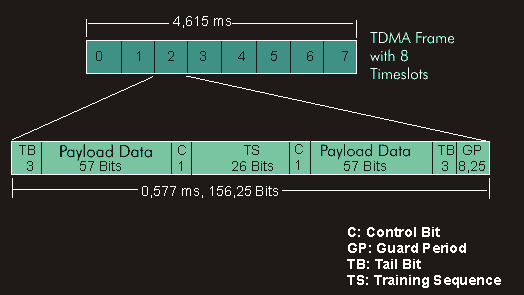GSM frame
GSM operates in the 900 MHz range on two separate radio channels, each 25 MHz wide, from 890 MHz to 915 MHz for the uplink and from 935 MHz to 960 MHz for the downlink.
Each channel is divided into eight time slots, which are transmitted in time sequence using the TDMA method. The entire TDMA frame consists of 1733 time slots per second, which corresponds to a length for an eight-part TDMA frame of 4.615 ms. The TDMA time slots are transmitted in frequency hopping mode. A hopping frequency duration of 4.615 ms results in 216.68 frequency h ops per second. The transmission on the radio channel is binary with a data rate of 270.8 kbit/s. In terms of a TDMA time slot, this results in 156.25 bits/slot or a duration of 576.9 µs. Only 148 bits/slot are transmitted because of the need to maintain safety intervals between the time slots. The remaining 8.25 bits form the safety margin, the so-called guard band, which is used for frequency switching and settling and is intended to prevent overlapping of data packets from different transmitters.
A time slot is divided into two times 57 data bits and a 26-bitpreamble. Between the data and the preamble there is 1 control bit each and at the borders to the neighboring slots there are 3 tail bits each.
The preamble is known to the receiver and allows synchronization to the receive signal and derivation of response parameters. From the preamble, the TDMA slot is symmetrical. In front of the data packet there are control bits which provide information about the content of the data packet. Thus, the data packet can contain user data of type Bm (Bearer Mobile) or Lm (Low Mobile) or also signaling data. The actual traffic data is contained in the data blocks, which are twice 57 bits long.

